The Regordane Way |
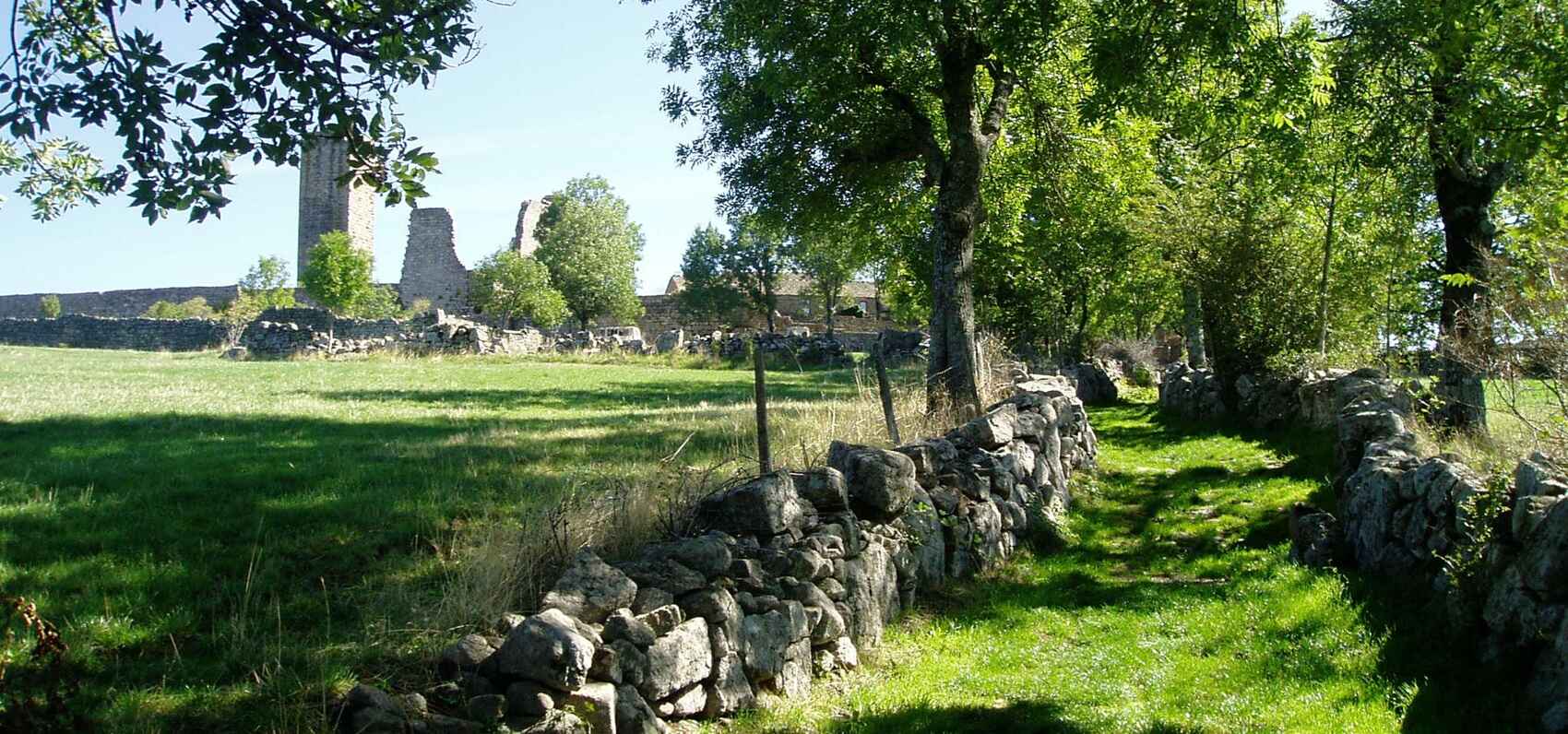
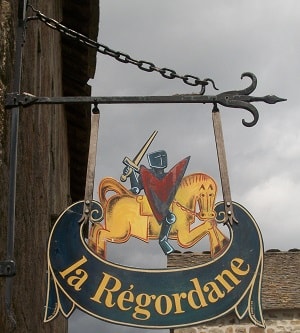 This very ancient path was born long before the appearance of man after a north-south dislocation with the shifting of plates opened passes, particularly the most important one, which south of Villefort provides a low-altitude passage through a 60-kilometer long barrier formed by Mont Lozère and the Mas de l'Aire mountain range.
This very ancient path was born long before the appearance of man after a north-south dislocation with the shifting of plates opened passes, particularly the most important one, which south of Villefort provides a low-altitude passage through a 60-kilometer long barrier formed by Mont Lozère and the Mas de l'Aire mountain range.
The fault has generated many springs that line it. The first animals instinctively followed it, from spring to spring, from pass to pass, in a spontaneous movement of transhumance.
Man followed the animals, millennia later, by creating a drovers' track, a simple path. Some believe, not without reason, that tin convoys used it between the Phoenician ports of Saint-Valéry-en-Caux in Normandy and Saint-Gilles.
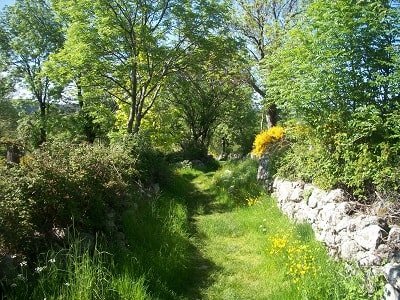 The Romans undoubtedly followed it to transport metals that were extracted on either side in places dedicated to the god of commerce and industry, Mercoire, Mercoirol, Mercouly. But it was not yet a major axis as it became in the Middle Ages, after the division of the Carolingian Empire which placed the Rhône valley in the Germanic Empire and made the Chemin de Régordane the most eastern route of the Kingdom. It was during this time (12th-13th centuries) that transport developed due to advances in harnessing when it was realized that it was by their weight that animals pull (like man, by the way) and not, as one might read in textbooks, due to the discovery of shoulder traction that the Egyptians practiced at the time of Tutankhamun, fourteen centuries B.C.
The Romans undoubtedly followed it to transport metals that were extracted on either side in places dedicated to the god of commerce and industry, Mercoire, Mercoirol, Mercouly. But it was not yet a major axis as it became in the Middle Ages, after the division of the Carolingian Empire which placed the Rhône valley in the Germanic Empire and made the Chemin de Régordane the most eastern route of the Kingdom. It was during this time (12th-13th centuries) that transport developed due to advances in harnessing when it was realized that it was by their weight that animals pull (like man, by the way) and not, as one might read in textbooks, due to the discovery of shoulder traction that the Egyptians practiced at the time of Tutankhamun, fourteen centuries B.C.
The road was then traced on the high plateaus of the Thort, Molette, and Garde-Guérin. It was carved into the schist on the slopes of the Cèze valleys. In the villages, houses were built on vast warehouses that open onto the main street through pointed arch doors, remnants of which can be seen in Génolhac in the Gard. Vehicles, small in size and bearing little more than 500 kilograms due to the materials used to construct them, circulate there.
An epic poem, the Charroi de Nîmes, in the second half of the 12th century, evokes this region of Régordane where there are "carts and wagons in abundance," "char and carts in great numbers" (v.950). If this is the case, it is because at that time, the climate, similar to the one we know, is favorable to the growth of plants. Harvests are abundant and create wealth that must circulate. It is a prosperous time that can afford to build cathedrals that we would be hard-pressed to begin. Without the schist, carts with a 1.40-meter wide path dig ruts through their passage repeated a hundred times, like wooden clogs that eventually wear down the stone threshold of the house.
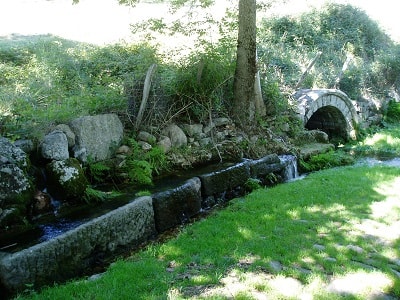 But the climate changed in the 14th century, becoming cold and humid. Food became scarce, and the weakened population was halved by the plague while the Hundred Years' War devastated the country. Transport ceased, and the road deteriorated. The Chemin de Régordane saw only mule convoys, some loaded with silver or saffron, being robbed by the English Bandits.
But the climate changed in the 14th century, becoming cold and humid. Food became scarce, and the weakened population was halved by the plague while the Hundred Years' War devastated the country. Transport ceased, and the road deteriorated. The Chemin de Régordane saw only mule convoys, some loaded with silver or saffron, being robbed by the English Bandits.
It was not until the end of the 17th century, perhaps due to the King's attention to the Protestant Cévennes, that the Chemin de Régordane came back to life. The road was repeatedly modified, constructed, destroyed by runoff water, repaired, or even rebuilt because, in these mountains exposed to the Midi, early autumn storms quickly uprooted the gravel, the mixed material with which the road was covered at that time. The Bayard slope, between Villefort and Garde-Guérin, had to be rebuilt every ten years. At first, it rises straight up from the village of Bayard, all in winding paths, like a precise inspection report. In the mid-18th century, this difficult path was abandoned for a completely new road that hugs the slope descending from Cham Morte: it is the old road still used today, quite dilapidated, with a remnant of paving that some say is "Roman" although it was laid during the First Empire!Wagons, narrower than those of the Middle Ages, copied from those of Velay, roll again on the Régordane path and dig ruts with a width of 1.20 meters.
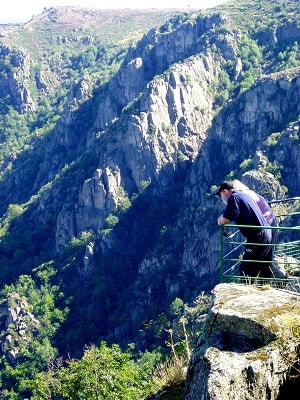 During the 19th century, the current road was built, all in curves (not long ago we counted 650 turns from Alès to Pradelles in Haute-Loire) to soften the slopes and allow diligence horses to trot. Our powerful cars must adapt to it!Over time, the road shifts. There remain fixed points, passes that cannot be avoided. But between them, the road passes here and there. Like the telephone wires that remain attached to the insulators but sway to the whim of the wind.
During the 19th century, the current road was built, all in curves (not long ago we counted 650 turns from Alès to Pradelles in Haute-Loire) to soften the slopes and allow diligence horses to trot. Our powerful cars must adapt to it!Over time, the road shifts. There remain fixed points, passes that cannot be avoided. But between them, the road passes here and there. Like the telephone wires that remain attached to the insulators but sway to the whim of the wind.
However, this road has not just been a simple trade artery. For centuries, it has channeled pilgrims who, from the "north," descend to venerate the tomb of Saint Gilles in his Provençal abbey, south of Nîmes. Medieval literature reveals the importance of this sanctuary and the place it occupies in it designates it as the first pilgrimage in our country.
Saint Gilles is praised as the only saint who never fails those who invoke him with faith. Therefore, many gather there, in such numbers that 134 money changers find a living. In Saint-Gilles, one can also embark for Rome and Jerusalem, as it is a flourishing port on the Petit Rhône, which will not be dethroned until Aigues-Mortes, after 1240, while waiting for Marseille to become French in the 15th century. If Saint-Gilles has been a stop on a pilgrimage route, it is indeed on that of the Holy Land, much more than on that of Compostela, as no Jacquaire is known to have lingered at the tomb of the hermit with the doe.
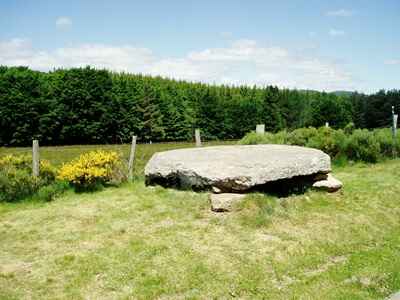 Finally, this road has a name: it is the Chemin de Régordane (this is the expression by which it is referred to in ancient documents; the improper name of Voie Régordane - to make it "Roman" - only appears in the 20th century). It takes its name from the region of Régordane that it crosses, just like the Chemin de Forez takes its from the surrounding mountains. This region, and even this province - provincia de Regordana in 1323 in a document from the Portes castle, would correspond approximately to the territory extending between the towns of Alès in Cévennes, Chamborigaud, Pradelles, and Largentières.
Finally, this road has a name: it is the Chemin de Régordane (this is the expression by which it is referred to in ancient documents; the improper name of Voie Régordane - to make it "Roman" - only appears in the 20th century). It takes its name from the region of Régordane that it crosses, just like the Chemin de Forez takes its from the surrounding mountains. This region, and even this province - provincia de Regordana in 1323 in a document from the Portes castle, would correspond approximately to the territory extending between the towns of Alès in Cévennes, Chamborigaud, Pradelles, and Largentières.
Its name, related to gord, gourd, frequent throughout our country, would designate a land of deep valleys, which corresponds well to its physical reality. Thus, the Chemin de Régordane is designated by this name in the consulted documents only between Luc and Alès.
Here is the story of this prestigious path that cannot be summarized in a few lines and which will be elaborated elsewhere. Today the road has been dormant for more than a hundred years, like Sleeping Beauty: has Régordane not also been a woman's name! It is up to you to become her charming prince and awaken her, follow her while being attentive to her remnants, to the beauty of the landscapes she crosses which change as, from Puy-en-Velay to Alès, one loses altitude.
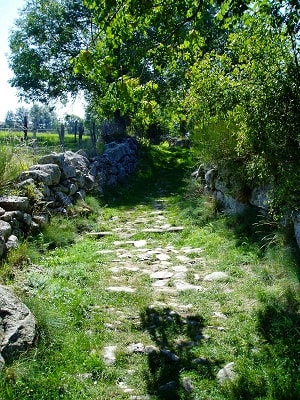 Watch for the appearance of the first chestnut trees under Garde-Guérin, the green oaks as you approach the Cèze valley, the first vine stocks at Vielvic, the olive trees after crossing the Mas-Dieu pass, and many other things.
Watch for the appearance of the first chestnut trees under Garde-Guérin, the green oaks as you approach the Cèze valley, the first vine stocks at Vielvic, the olive trees after crossing the Mas-Dieu pass, and many other things.
Be attentive to read its remnants, its ruts carved into the schist, its Côte Bayard whose dry stone retaining walls have resisted for two centuries, with its buttresses (the ancestors of our safety barriers) and its beautiful remnants of paving.
So, take your stick, your bag, and set off to discover the Chemin de Régordane. Text prepared by Marcel Girault, July 2000. The Chemin de Régordane. Nîmes, Lacour, 3rd ed. 1988. - History enthusiasts can read the thesis that the author dedicated to this road (Tours, 1980).
The most interesting section of the Chemin de Régordane is situated between La Bastide-Puylaurent and Génolhac (to be discovered in that direction). To traverse this prestigious route without getting lost, one can refer to the guide prepared by Marcel Girault, Le Chemin de Régordane, Guide for the use of pilgrims to Saint-Gilles, Régourdiers, and other walkers, from Puy-en-Velay to Saint-Gilles du Gard. Nîmes, Lacour, 1998: description of the itinerary, schematic maps, and notes.
It has fallen asleep, or more precisely, dozed off... To walk it is to give it life again because its vocation was movement. That of Arverne and Greek merchants. That of knights, pilgrims, and peddlers. Of jugglers and troubadours. A route for wine, spices, simple salt, as well as oil and cheese. But also a "strategic" route for tin towards the Mediterranean. Of Frankish chivalry marching against the Saracens.
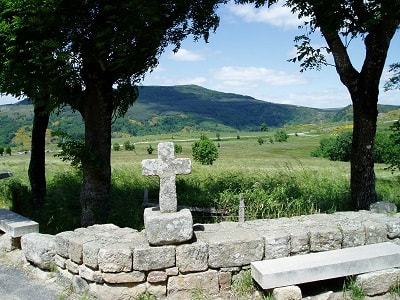 From the monk on pilgrimage to Saint Gilles and perhaps the East. A path of stars in the Milky Way of the journey that was the Middle Ages.
From the monk on pilgrimage to Saint Gilles and perhaps the East. A path of stars in the Milky Way of the journey that was the Middle Ages.
The journey of priest Aulanier from Brignon on the Chemin de Régordane in the 17th century.
November 16, 1644: early in the morning (departure) for the journey from Nîmes in Languedoc to dine in Pradelles where he spent 16 sols; in Pranlas a snack for my horse and a meal: 5 sols 6 deniers and supper and lodging at La Bastide, 23 sols.
November 17: left at dawn from La Bastide, dined in Villefort at the lodging of the three kings, spent 17 sols 6 deniers; snack and a bite in Génolhac, 4 sols 6 deniers; supper and lodging at Pradel at a place called Fornier, spent 19 sols 9 deniers.
November 18: left Pradel at dawn, Abbé Aulanier dines at Lège d'Alais where he spends 23 sols 3 deniers for himself and his horse; he has a snack and gives oats at the Barraque de la Bitarelle where 9 sols 6 deniers are spent; and finally he arrives for supper and lodging in Nîmes which costs him 25 sols 9 deniers including 2 sols at the port.
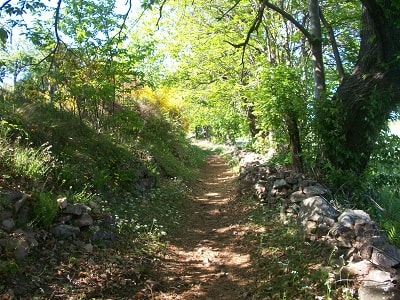 P. Grelet de la Deyte, at the end of the 17th century, made two trips between Puy and Montpellier:
P. Grelet de la Deyte, at the end of the 17th century, made two trips between Puy and Montpellier:
“I made two trips to the city of Montpellier, one in June of the year 1681 and the other in January 1692. To get there, it is necessary to pass from Puy to Bisac, to Costerot, to Sauvetat, to Pradelles, to Langonhe, to Luc, to Pranla, to Regletout, to the chapelle Saint Thomas, to Tord, to Molete, to Garde Guérin, to Bayard, to Villefort, to Viluy, to Genoulhac, to Chamber Rigau, to Porte, to Pradel, to Maviau, to Saint Martin, to the city of Allex, to the Taverne, where you must cross the Gardon river, to Ladinghan, to Crepian and to the chapel, to the city of Soumiere, to Formaingnhe, to Pont Neuf and to Montpellier. From here to Montpellier, it is about 35 leagues.” PAYRARD, J.B. Petites éphémérides vellaviennes. 1889, Le Puy-en-Velay. " The reason book of Louis Jouve " in Bulletin historique et scientifique de l'Auvergne. Tome XXXIII, n°603, 1964.
It has fallen asleep, or more precisely, dozed off... To walk it is to give it life again because its vocation was movement. That of Arverne and Greek merchants. That of knights, pilgrims, and peddlers. Of jugglers and troubadours. A route for wine, spices, simple salt, as well as oil and cheese. But also a “strategic” route for tin towards the Mediterranean. Of Frankish chivalry marching against the Saracens. From the monk on pilgrimage to Saint Gilles and perhaps the East. A path of stars in the Milky Way of the journey that was the Middle Ages.
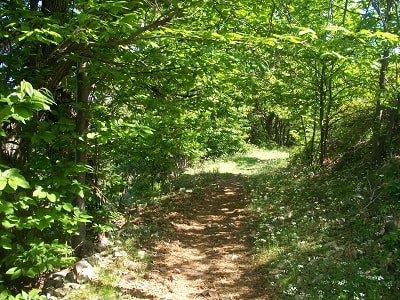 To say that Lozère is isolated is to ignore its history or at least reduce it to the era of railways...
To say that Lozère is isolated is to ignore its history or at least reduce it to the era of railways...
Lozère, and even more so its original province Gévaudan, not only has never been isolated until the mid-19th century but can even be considered as a particularly strong area of major passages, confluences, and roads where kings, peddlers, monks, knights, and merchants, herds, and transports intersected intensively. The motives for such circulation were varied and intertwined: religious, economic, military, pastoral; above all it was an essential and privileged contact zone between a Mediterranean civilization (whether Greek, Roman, or Arab) and a Nordic world, the mysterious lands of tin and dark forests, governed by Celtic-Germanic peoples.
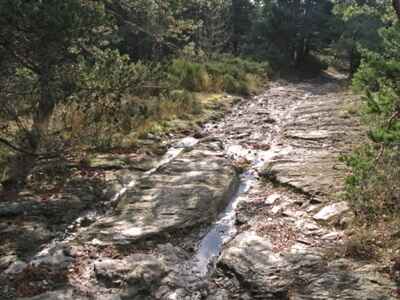 Among the countless roads, paths, or drovers' tracks that still traverse our province; one may be particularly close to us: it is the Voie Régordane, a trail that linked Nîmes to Puy-en-Velay and the Arverne country; the Mediterranean to the barbaric world of Gaul, even to the strange lands of Brittany and Ireland.
Among the countless roads, paths, or drovers' tracks that still traverse our province; one may be particularly close to us: it is the Voie Régordane, a trail that linked Nîmes to Puy-en-Velay and the Arverne country; the Mediterranean to the barbaric world of Gaul, even to the strange lands of Brittany and Ireland.
The origin of this path is lost in the mists of time. Probably a natural transhumance path, then a pastoral route in prehistoric times, it quickly enriched itself with the circulation of goods during the Roman era between the Arverne country and the Volscian territory centered around Nemausus (Nîmes): wine for weapons and jewelry; oil and salt for grains and cheeses... with the advancement of wheeled transport, the maintenance and then the widening of the roads became organized... tolls and "protections" also arose because the area is not safe and this circulation of wealth attracts; especially those made up of eastern products (silks, spices) arriving through the port of Saint Gilles and going up to the famous fairs of Champagne.
Meeting places and trading posts were established, the beginnings of the towns and villages we know today: Génolhac, Langogne, La Bastide Puylaurent, Villefort, stages, shelters, warehouses for a trade that enriched the surrounding populations. Fortresses also appeared, such as the castle of Portes or the Garde-Guérin which protect (or hinder) these economic currents but also cultural ones.
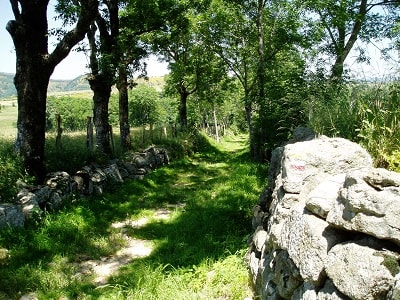 Naturally, the GR®700 also became a pilgrimage route. As lodging houses, guest rooms, hotels, and other inns flourished, so did places of worship and their assortments of relics that our Middle Ages have so deliciously kept secret.
Naturally, the GR®700 also became a pilgrimage route. As lodging houses, guest rooms, hotels, and other inns flourished, so did places of worship and their assortments of relics that our Middle Ages have so deliciously kept secret.
Just to the north, towards Puy-en-Velay, passes the path of Saint James of Compostela. The one of the Teutons, which drains all of northeastern Europe towards the Marian Sanctuary of Puy-en-Velay. A crossroads for the Jacquets and other pilgrims who, via the Régordane, will take a descent toward the great Monastery of Saint Gilles and its port with numerous destinations.
A religious, tourist, and cultural path as well, where ribaldry and feasts mingle with troubadour songs and epic tales, embellishing a somewhat “long” pilgrimage. The innkeepers of this time took care of hospitality and did not ignore entertainment... the warrior tales of the Crusades - and we know that toward the Midi and Spain, the Crusades were largely earlier than the Crusaders - offer a backdrop of dreams and stories for the long nights in the mythical Cévennes valleys.
One must follow the Voie Régordane, discover its ancestral pavings, whether Roman or "French." One must observe under the vegetation the ruts left in the rock by heavily loaded carts of mysterious goods with uncertain destinies; these towns and considerable porches that swallowed horses and mules, bundles and peddlers at dusk, only to return them in the morning in the sunny freshness of colors, murmurs, and scents...
Along our journey, we must learn to read the worries, hopes, and myths left by our ancestors from that time in the many traces they left behind.Guilhem au cort Nes, Fierbrace is still there, present, and the hooves of his steed still resonate on the ancestral slab. He who took the Régordane from Puy-en-Velay to retake Nîmes from the Saracens. "Infidels who believe neither in the true God nor in Lady Mary." They therefore deserve exemplary punishment:
They wear hauberks, fasten their helmets tight
They bear hopes adorned with golden ponze
They mount the saddles of their alert destriers;
Their strong buckled shields hang from their sides,
And on their points are adorned the noiled spikes.
From the town they emerge, well-armed and lined up,
Before them they carry the oriflamme
Straight towards Nîmes they make their way.
All ten thousand of them, well-armed Franks
Prepared for battle...
They rode through the fields and woods
Through Régordane they passed on,
To the Puy they never stopped...
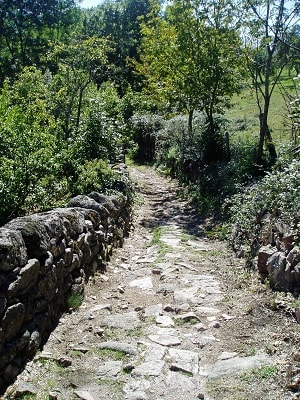 Ten thousand knights on the Régordane? The path has lived its glorious hours. Too much prosperity, too much joy, would it kill? Would a millennia-old story sink into oblivion? Like Merlin still alive at the bottom of the lake, the Régordane slowly sinks into the waters of oblivion.
Ten thousand knights on the Régordane? The path has lived its glorious hours. Too much prosperity, too much joy, would it kill? Would a millennia-old story sink into oblivion? Like Merlin still alive at the bottom of the lake, the Régordane slowly sinks into the waters of oblivion.
From the end of the 14th century when the Hundred Years' War led to our territory being neglected for the favor of Germany and Flanders. The Rhône valley and the free fairs of Lyon will definitively extinguish its economic interest. Resurrected in the 18th century by royal will, it withers again as its life is elsewhere. Nothing left? Ruins, brambles, pavings, a road. It is here, it is there... But does it hold captive within its flanks any sirens? The music is indeed there, which remains.
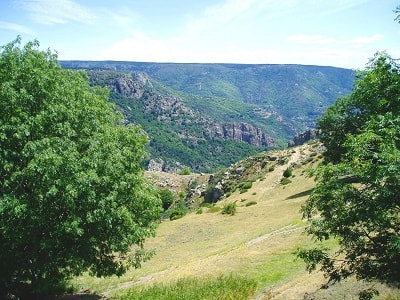 Fragrances and bells endlessly recount its countless legends. And from the disjointed pavings emerges an ancient song. Enveloping and eternal are its shores. And its mirages lead nowhere except to the end of our dreams.
Fragrances and bells endlessly recount its countless legends. And from the disjointed pavings emerges an ancient song. Enveloping and eternal are its shores. And its mirages lead nowhere except to the end of our dreams.
Chemin de Régordane or Voie Régordane
Only the expression Chemin de Régordane is correct if one refers to the ancient forms that we have collected since the 12th century: itinere pubblico regordane, iter publicum regordane, strata publica de regordane, carreriera publica regordane, grand camy de regordane, caminus Regordane, Chemin de Régordane.
The poet Mistral, whose scholarship has never been contested, calls it camin regourdan. Moreover, Regordane is the name of a region, of a land, even a path of a province, which would approximately extend from Alès to Pradelles and Largentières as we have shown elsewhere (Le Chemin de Régordane, Ed. Lacour, Nîmes). Chemin de Régordane is the name given to the major axis that crosses the land of Régordane, just as to the north Chemin de Forez designates the main road that crosses this region and even further, Canal de Berry applies to the waterway serving this province. Notably, the preposition “de” is used. The expression voie Régordane, which is widespread, has only been retained since the 19th century to give this road an improbable Roman origin. We have noted this expression only once, in the 18th century, moderated by its French translation, via regordia, vulgarly chemin de régordane. Furthermore, this expression was then used in the context of a polemic. by Marcel Girault
Former holiday hotel with a garden along the Allier, L'Etoile Guest House is located in La Bastide-Puylaurent between Lozere, Ardeche, and the Cevennes in the mountains of Southern France. At the crossroads of GR®7, GR®70 Stevenson Path, GR®72, GR®700 Regordane Way, GR®470 Allier River springs and gorges, GRP® Cevenol, Ardechoise Mountains, Margeride. Numerous loop trails for hiking and one-day biking excursions. Ideal for a relaxing and hiking getaway.
Copyright©etoile.fr